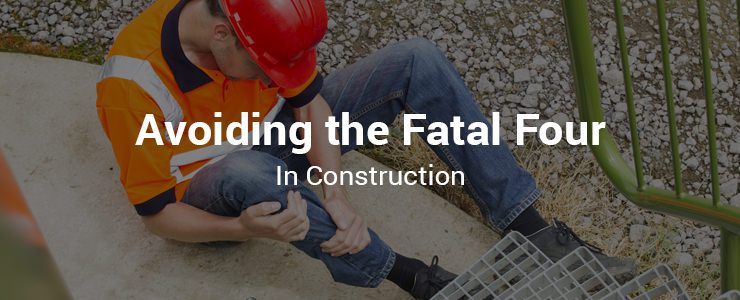Avoiding The Fatal Four In Construction
Industry Trends | By | 2 Jun 2016 | 3 minute read

In 2014, 20.5% of all worker fatalities were in construction. That equates to one in five worker deaths last year. Of those construction fatalities, a full 58% were comprised of the “fatal four” causes; falls, being caught between objects, electrocution and being struck by an object. Construction sites inevitably pose many safety risks, but the fatal four are responsible for a majority of incidents. Let’s take a look at the culprits and how you can avoid them.
Falls
Falls were the largest culprit in 2014, causing 349 fatalities, 39% of the industry total deaths. Nearly all of those falls were due to lower level falls. Falls like these could easily be prevented with appropriate signage and awareness of risks on construction sites. 163 of those lower level falls occurred from 20 feet or less.
Overall, falls to lower levels accounted for 250 fatalities in 2014. Studies have shown that using guardrails, fall arrest systems, safety nets, covers and restraint systems can greatly reduce the risk of injury and death. These may seem like elementary practices, but they can often be overlooked due to their simplicity or due to hasty setup procedures. Wall openings, floor holes, ladders, scaffolding, roofing are just a few of the potential hazards workers come across that can contribute to a fall. A general site inspection or pre-work inspection checklist would be helpful in assessing the risks that each construction site possesses.
The results of not wearing safety harnesses are grim. In 2009, a Toronto construction project manager was sentenced to three and a half years prison for a scaffolding collapse on an apartment building job site. Four workers were fatally injured after they fell 13 storeys while working on the high-rise building.
Electrocutions
Electrocutions accounted for 74 deaths (8.5%). Of this category, 42 deaths were due to direct exposure. 56 deaths from this category were from exposure to more than 220 volts.
In order to avoid incidents, employers should be conducting site inspections to determine all the electrical hazards on site and their locations. Employers can establish an equipment grounding conductor system and keep a detailed record of all tests and inspections. Inspecting power tools, equipment and extension cords for cuts, frays and exposed bare wires can ensure the safety of workers.
Posting warning signs or conducting a morning toolbox talk can alert workers of the electrical risks they might face on the job. Employers can provide proper PPE including insulated gloves and guards on power tools. Protective equipment should always be worn when working with electrical systems. Only allow employees with the correct training to handle electrical systems to ensure they use the lockout and tagout systems.
Struck-by Incidents
73 construction fatalities in 2014 was due to workers being struck by equipment or objects. The types of struck-by incidents are caused by four particular categories: objects flying through the air, objects falling from a higher level, objects swinging through the air, and sliding or rolling objects. Falling objects or equipment accounted for 39 of these deaths, while non-transport vehicles caused 22 construction fatalities.
To decrease the risk of these types of incidents, train and alert your workers to best practices about where to position themselves between moving and fixed objects on the work site. Hard hats should be worn and tools should be put away. High visibility clothing is essential to prevent vehicles, falling loads or excavation collapses fatally injuring workers. Best practices and risk assessments can be displayed and communicated through a safety inspection system. There is technology on the way to help this too.
Caught-in/between Incidents
Workers who were caught in, or suppressed by an object or piece of equipment resulted in 12 fatalities last year.
How caught-in incidents can be prevented
Although this seems like common sense, but when concentrating on the job at hand it is easy to find yourself in danger. Just like struck-by incidents, when your workers are constantly reminded of safety best practices through the use of regular inspections, these can be prevented.
Nearly all incidents as a result of the fatal four are preventable through training, safety procedures and a safe worker attitude is adopted. Proper safety equipment and regular inspections are key to keeping workers safe on construction sites. Addressing the common violations from OSHA is a great place to start in ensuring your workers are able to go home at the end of each day.
Important Notice
The information contained in this article is general in nature and you should consider whether the information is appropriate to your specific needs. Legal and other matters referred to in this article are based on our interpretation of laws existing at the time and should not be relied on in place of professional advice. We are not responsible for the content of any site owned by a third party that may be linked to this article. SafetyCulture disclaims all liability (except for any liability which by law cannot be excluded) for any error, inaccuracy, or omission from the information contained in this article, any site linked to this article, and any loss or damage suffered by any person directly or indirectly through relying on this information.





